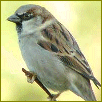|
|
House Sparrows Research Summary |
|
Investigating the causes of the decline of the urban House Sparrow Passer domesticus population in Britain: researched by Kate Vincent of De Montfort University in collaboration with the RSPB and English Nature Aim of the House Sparrows project: To establish why a species that historically has been so common is now dramatically declining in some urban areas of the UK, through quantifying important demographic parameters such as productivity and survival across urban, suburban and rural habitats. I also investigated foraging habitat selection by adults, chick diet, factors affecting chick condition and nesting success and over-winter survival to gain an insight into why urban House Sparrows might be declining. Background: House Sparrow numbers are declining at alarming rates, especially in urban and suburban habitats in many European cities. There has been a well-documented decline in House Sparrow populations in cities such as London, Edinburgh, Hamburg and Paris. In August 2002, the House Sparrow was added to the Red Data list of bird species of conservation concern because the decline had been more than 50% in the last 25 years. Between 1977 and 2000, House Sparrow numbers in the UK have declined by 65%. The Garden Bird Feeding Survey (run by the British Trust for Ornithology ) data has shown that the House Sparrow population has declined by some 58% since 1970 in gardens during winter, of which suburban gardens have shown a greater decline (60%) than rural gardens (48%). Hypotheses:
Summary of Findings Data were collected during 2001-2003 from 9 study areas spread along the urbanisation gradient. Over 600 nest boxes were erected on houses across these study areas. Most House Sparrows in most study areas nested in or close to domestic gardens. Nest boxes were checked on a weekly basis to record the stages of occupation from nest-building to the number of eggs through to the number of chicks that were hatched . Annual productivity (the estimated number of fledged young/pair/year) was 25% lower in suburban areas and 18% lower in rural areas than that measured during a recent study of farmland House Sparrows in Oxfordshire. The main cause of this lower productivity was starvation of chicks, usually the first 5-6 days after hatching, during June and July. Through the analysis of nestling diet it was established that chicks were more likely to starve if their diet contained a high proportion of vegetable material (mainly supplementary food) or ants, and less likely to starve if their diet contained a high proportion of spiders. Habitat mapping around each occupied nest box was undertaken and it was found that the number of young sparrows successfully fledging, and the aggregate chick biomass, per nesting attempt were greater in home ranges containing relatively high proportions of deciduous shrub, trees and grass, and relatively little concrete. During June and July 2003, more young fledged from home ranges containing a higher density of aphids. Dipteran prey (Tipulids and other flies) constituted a higher proportion of the chick diet in rural localities than in urban-suburban localities, while Homopteran prey (mainly aphids) constituted a higher proportion of chick diet in urban-suburban localities. The condition of each chick was monitored through weekly measurements of mass, tarsus length and fat and muscle score. Each chick was colour-ringed in order to monitor their progress in the field once they fledge from the box. After allowing for effects of weather, it was found that nestling body mass and condition were negatively correlated to local levels of nitrogen dioxide air pollution. Since body mass at fledging is known to be a good predictor of immediate post-fledging survival, I predicted that the lower average body mass at fledging among suburban broods (compared to rural broods) would result in lower survival during the first 10 days after fledging (57% for suburban fledglings, compared to 70% for rural fledglings). The combined effects of lower annual productivity and lower predicted post-fledging survival in suburban localities were large enough to result in rapid predicted population decline, given plausible annual survival rates of adults and first-year sparrows and no net immigration. Deciduous shrubbery, grassy areas and concrete were the main summer foraging habitats of suburban and rural House Sparrows, with trees being heavily utilised in 2003. Ornamental and evergreen shrubs were strongly avoided by foraging sparrows. Stable isotope ratios of nitrogen (d15N scores) in chick feathers are proposed to constitute a useful integrated measure of the quality of the chick diet. d15N scores differed markedly between the vegetable (2.7), herbivorous invertebrate (4.7-6.4) and carnivorous invertebrate (7.1-7.7) components of chick diet. d15N scores in sparrow chick feathers averaged 7.7 suggesting that the average d15N score of ingested diet was approximately 4.7 (i.e. was probably dominated by vegetable material and herbivorous invertebrates). Feather d15N scores were lower in home ranges containing relatively large areas of concrete and evergreen vegetation, and were a positive predictor of chick growth rate and body condition. The data presented in this thesis suggest that the abundance of invertebrate prey within home ranges of House Sparrows breeding within suburban and rural garden habitats limits the quantity and quality of chicks raised to fledging. The combined effects of relatively high rates of chick starvation and low body masses at fledging (and consequently low post-fledging survival) observed in suburban localities are large enough to result in rapid population declines. Invertebrate abundance in suburban areas is probably determined, at least in part, by the availability of suitable habitat including native deciduous shrubbery, tress and grassland. Although there is no evidence that the abundance of key invertebrate prey have declined in urban-suburban landscapes, such declines do provide a plausible mechanism for the observed declines in urban-suburban House Sparrow populations. Management techniques, which increase densities of key invertebrate prey during summer, have the potential to increase the annual productivity and possibly the breeding densities of House Sparrows in urban-suburban landscapes. In 2008 collaborative research, Reproductive success of house sparrows along an urban gradient, was published in the Journal of Animal Conservation |


